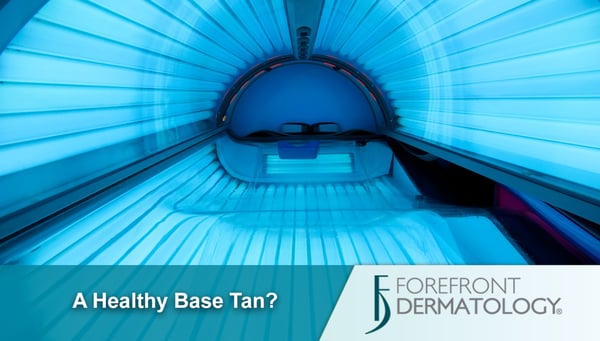
True or False: It’s healthy to get a base tan before heading out on your winter vacation.
If you haven’t heard the term “base tan” before, let me explain. Many individuals believe that before heading to a tropical destination, you should go tanning to develop a “base tan” to help avoid getting sunburn while on vacation. While the theory sounds reasonable, it is entirely false.
According to Dr. Peter Katz, board-certified dermatologist with Forefront Dermatology, “there is no such thing as a healthy or safe tan. Tanned skin is a result of damage to the skin cells, your skin producing pigment in response to UV damage in an attempt to protect itself. Over time, the damaged skin cells can lead to wrinkles, age spots, premature aging and even skin cancer.” Studies have shown that as many as 90 percent of melanoma cancer cases, the deadliest form of skin cancer, are caused by tanning exposure. Dr. Katz stated, “while the theory believes that a base tan protects you against sunburns, there is little evidence to support that theory. In fact, even a relatively deep “base tan” only equates to about an SPF of 2 or 3, and a tan from a tanning bed which consists primarily of UVA only can provide about an SPF equivalent of 1.5.”
Fight the Addiction
It might sound crazy to refer to tanning as an addiction, but tanning today is more popular than ever despite a well-documented significant increase in melanoma with use of tanning beds. Research has shown that tanning is as addictive as other cancer-causing activities such as smoking. The UV light emitted by tanning beds is shown to increase the release of endorphins, the feel-good chemicals that relieve pain and generate feelings of happiness. If you are addicted to maintaining that summer glow throughout winter, consider the new alternative. Spray tans, or sunless tanning lotions, are a great option to getting a sun-kissed glow without the damage sun tanning causes.
Prevention is Key
Ultimately the best logic to follow for preventing sunburns is to use common sense. Instead of heading to the tanning bed before your winter vacation follow these methods suggested by Dr. Katz:
• Avoid sun exposure between 10 a.m. and 4 p.m. when the sun’s UV rays are at their strongest. If you have to be outside during this time, seek shade instead of sitting in direct sunlight.
• While outside cover up with woven clothing specially designed to provide sun protection. A broad-brimmed hat and sunglasses with a high UV protection rating are recommended to keep your head, neck and eyelids protected.
• Apply a broad-spectrum UVA/UVB sunscreen with an SPF of 30 or higher frequently and liberally. Apply the sunscreen a half hour
before going outside and reapply every two hours. If you are swimming or sweating, you will need to reapply every 45 to 60 minutes.
Sunscreen is needed whether you are in the sun, the shade or if it’s a cloudy day. UVA rays, which you don’t feel nearly as much as UVB, come right through clouds and are just as strong in the winter as in the summer. UVA rays increase risk of skin cancer, brown spots and, because they penetrate deeper into the skin, damage collagen making UVA the major cause of wrinkles.
Remember, these tips don’t just apply to those taking a beach vacation. If you are taking a trip to the mountains, you are also at risk of UV exposure. Because snow is white, the sun directly reflects off the snow causing you to get double UV exposure. Being up in the mountains also increases your exposure to UV rays. For every 1,000 feet above sea level you climb, UV exposure increase eight to ten percent.
At the end of the day, the best answer to have that glow year-round is to stop falling for the media’s version of beauty and start accepting, and loving, the skin you were born with. There is nothing more glowing than that.
Skin Struggles?
If you are struggling with skin issues and don’t know where to turn, the skin health experts at Forefront Dermatology are ready to help. To find the Forefront dermatologist nearest you, visit the locations page today.





